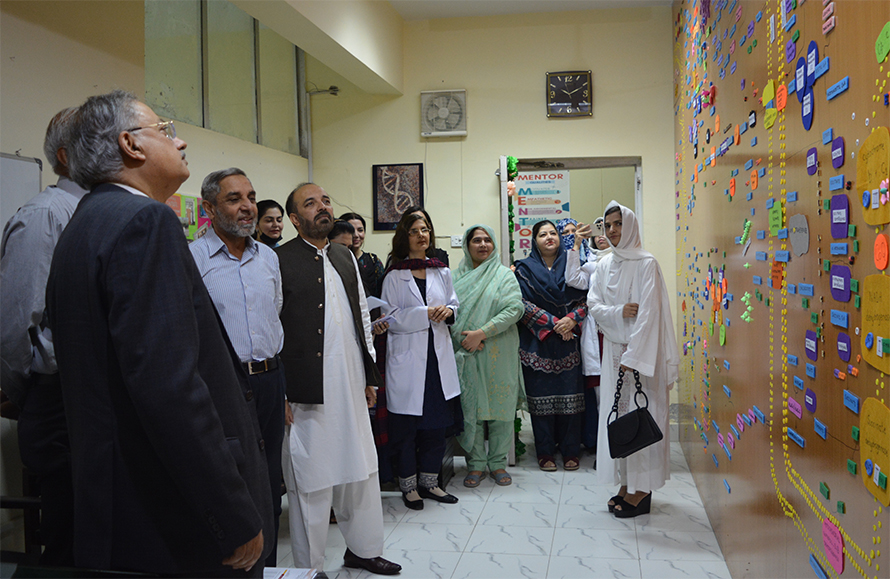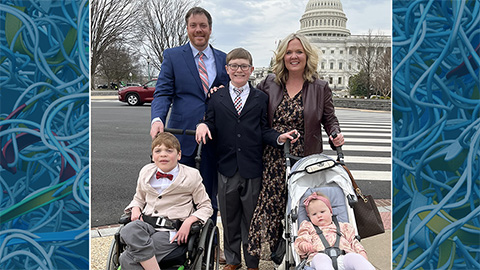On our wall: A bird’s eye view of metabolism
To understand the biochemical basis of life, disease and death, a student must first learn how the evanescent substances we call intermediates move and change through complex pathways and cycles. Vast amounts of scientific jargon make teaching about this metabolic map a challenge. When students look at versions of metabolic maps on a computer screen, they often feel lost in these mazes of complexity.
At Federal Medical College in Pakistan, we have constructed a map that gives students a big-picture view of metabolism at a glance. This can help them understand the complex pathways and their links as well as the applied aspects of biochemistry.
It took me years to integrate all the intricate pathways in my mind. Thinking about this, I became determined to make learning easier for my own students. I wanted to present the complexities of metabolism in a simplified format, providing them with a bird’s-eye view so they could appreciate the entire system, rather than getting lost in individual components.
Early in the 2022 academic year, as I was updating study guides for my students, I had the idea of making a metabolic map on my office wall. To make it simple and attractive, I decided to avoid chemical formulas, highlight only the key concepts and preserve the essential content in a visually appealing and interactive format.
On the one hand, this map would help imprint the complex pathways and their links into the minds of my students, so they’d grasp it as one big picture. On the other hand, it would present the applied aspects of biochemistry, creating a mind shift from what students often think of as a “dreary biochemistry text” to a fascinating biochemistry expedition.
I set to work alone but was overjoyed when more and more students joined the effort. With 21 volunteers helping, we completed the project in one year. Even more volunteers, both students and faculty, helped with a celebration after the map was completed.
To create this masterpiece, we used plastic corrugated boards and felt sheets, foaming clay, wooden alphabet blocks and a variety of stationery supplies. Our map features blue metabolites, green coenzymes and a multicolor scheme for the enzymes. We used 3D casts to represent some components, such as yellow dots for membrane lipids and white dots for protons. Yellow-dotted membranes create cellular compartments such as mitochondria and cytosol. ATP and other nucleotides are sculpted to make them stand out.

We used chemical or structural formulae only for very small molecules such as water, oxygen, carbon dioxide and ammonia. Tiny space-filling models are mounted on the wall to show how these miniature entities enter and exit the pathways. Arrows drawn directly on the wall with permanent markers signify the movement of molecules across membranes and the conversion of substrates to products.
When we were ready to share our map, we wrote a 15-minute script showcasing the potential of integrating biochemistry with pharmacology, forensic medicine, community medicine, pathology and molecular medicine. The script is a dialogue among my 21 student volunteers who discuss the significance of metabolism.
We videotaped the script and added digital images of patients and medications. The video, “Vertical integration through a metabolic map,” was uploaded on YouTube on our channel, “Dr Fatahiya Kashif’s Students,” in late 2022 — the first in a series. We added a second video, “Electron Transport Chain,” in May 2023.
The college celebrated the map’s completion in October 2022. We gave customized gifts and souvenirs with pictures of enzymes and metabolites to our volunteers and presenters.
To evaluate the effectiveness of our map, we solicited feedback from our students. Most responded positively.

Fatima Gulbahadur, a second-year student, wrote to me that the map “showed everyone that this is what biochemistry does for medicine, this is how important it actually is. All the disorders, enzymes with cute little models made it all so easy to get a picture of what’s going on inside our body.”
Aimen Javed wrote that “the map gave us a very good idea about how each and every metabolic process in our body is interlinked.”
“It was a fun activity which also helped us with our curriculum and helped us step out of our comfort zone and do something interesting,” Alishba Moheeuddin wrote.
“This map made me switch my learning from ratta system (a rote method) to conceptual and integrated system,” Faiqa Shabbir wrote.
“It motivated me to put all my heart into anything I’d attempt to do,” Noor-ul-Ain Aziz wrote. “Topics that seem boring and difficult to me can be made easier if only I experiment with the ways of learning.”
Before the map was created, “there was a rare interest of most students in biochemistry,” Mujahid Mustafa wrote, “but throughout the event the interest for the subject and its importance was crystal clear.”
This editable map is a dynamic resource. We used UHU patafix removable glue to mount the elements on the wall. While making the map, we kept on inserting, deleting and changing the locations of metabolites and related bits and pieces until we had the best possible positioning to fulfill the learning objective. And we can keep refining and improving it before each learning session with new batches of students.
Overall, our goal at Federal Medical College is to revisit how we teach and learn biochemistry. Better understanding is the key to new discoveries about novel therapies for disease diagnosis, monitoring and management. By creating a dynamic resource that students find engaging and exciting, we hope to inspire a deeper interest in biochemistry and its applications.
Enjoy reading ASBMB Today?
Become a member to receive the print edition four times a year and the digital edition monthly.
Learn moreGet the latest from ASBMB Today
Enter your email address, and we’ll send you a weekly email with recent articles, interviews and more.
Latest in Opinions
Opinions highlights or most popular articles

Debugging my code and teaching with ChatGPT
AI tools like ChatGPT have changed the way an assistant professor teaches and does research. But, he asserts that real growth still comes from struggle, and educators must help students use AI wisely — as scaffolds, not shortcuts.

AI in the lab: The power of smarter questions
An assistant professor discusses AI's evolution from a buzzword to a trusted research partner. It helps streamline reviews, troubleshoot code, save time and spark ideas, but its success relies on combining AI with expertise and critical thinking.

How AlphaFold transformed my classroom into a research lab
A high school science teacher reflects on how AI-integrated technologies help her students ponder realistic research questions with hands-on learning.

Writing with AI turns chaos into clarity
Associate professor shares how generative AI, used as a creative whiteboard, helps scientists refine ideas, structure complexity and sharpen clarity — transforming the messy process of discovery into compelling science writing.

Teaching AI to listen
A computational medicine graduate student reflects on building natural language processing tools that extract meaning from messy clinical notes — transforming how we identify genetic risk while redefining what it means to listen in science.

What’s in a diagnosis?
When Jessica Foglio’s son Ben was first diagnosed with cerebral palsy, the label didn’t feel right. Whole exome sequencing revealed a rare disorder called Salla disease. Now Jessica is building community and driving research for answers.

